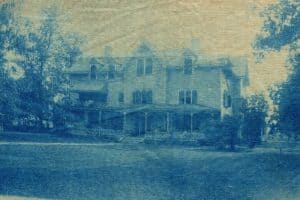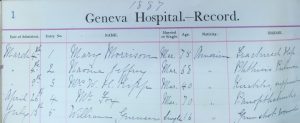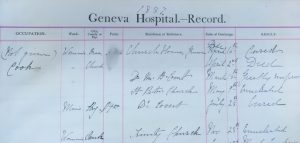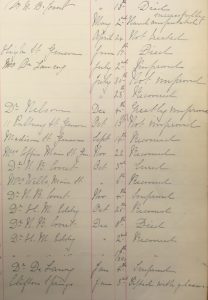Church Home Hospital
By John Marks, Curator of Collections and Exhibits

After 17 years I still find “new” things in our collection. In our archives we have several bookshelves of large ledgers that were used by businesses and organizations. Most have cloth covers but two are leather-bound with gold lettering on the spine.
The name on the spine caught my attention, then I opened the book to the first page. The name was accurate for the time but misleading to today’s reader. The modern Geneva General Hospital, under the name Geneva City Hospital, didn’t open until 1898. This was the ledger for the Church Home Hospital.

Original Church Home on Pulteney Street, razed to build DeSales High School. Fun fact: blue photographs are cyanotypes, or photographic blueprints.
In 1878 the Episcopal Church incorporated The Church Home on the Foster Swift Foundation. It provided care for the elderly with no family who could care for them. The modern equivalent would be a nursing home, including a stipulation that any property must be signed over to the Home.
In 1886 a hospital fund was started in memory of Emily H. Craven to expand the care available at the Church Home. According to the Trinity Episcopal Church centennial history in 1906, “Through this hospital the first trained nurses were brought to Geneva.”
Without an endowment, there were public fundraising events to support the hospital. The October 14, 1887 Geneva Daily Gazette stated, “As its doors are ever open to the unfortunate without distinction of faith or nationality, it appeals strongly to Genevans of all classes for support.”


The ledger contains almost as much interesting information as a census. In addition to dates admitted and discharged, there was marital status (married or single), age, “nativity” (the country of the patient’s birth), occupation, and residence. The book also noted if the patient was “colored.”

Treatment records were fairly simple. The Result column ranged from Died to Recovered with variations of Improved – Not, Somewhat, and Greatly.
Many patients had complications of common diseases while some were there for occupational injuries. Railroad brakemen often came in with broken or crushed appendages, some which required amputation. They operated each train car’s brakes from the top of the car, and worked between cars linking them together. Machinists were admitted with facial injuries, often a piece of metal embedded in an eye.
Treatment – Treatment records were fairly simple. The Result column ranged from Died to Recovered with variations of Improved – Not, Somewhat, and Greatly.
By 1892 the Church Hospital was not adequate for Geneva’s growing population. People were turned away for lack of beds and at least one surgery was done under a tent on the lawn. In that year the new Medical & Surgical Hospital of Geneva was incorporated (the name was soon changed to Geneva City Hospital). Trustees began fundraising but, like many projects, the hospital took longer than expected to open.
The Church Hospital continued to serve patients after the 1898 opening of the Geneva City Hospital. The ledger ended in 1899 but the hospital continued to appear in the annual report of the Church Home. It may have primarily served residents of the Home and members of the two Episcopal churches. The 1906 report states:
Patients treated in hospital, four; patients refused admission, not any; visits made to patients in [the Episcopal] parish, 19; visits made to patients in Church Home, 97. During the year Dr. Stebbins (the home physician), Dr. DeLaney and Dr. Eddy have kindly given their services.
The exhibit, Medicine and Illness: Health Care in Geneva, is on display at the Geneva History Museum, 543 S. Main Street, through June 16, 2018.

Very informative. I knew about the Church Home but not that it served as a Hospital.
Thanks, John
Per the 1922 U. S. City Directory, Harriet Warnock was the head nurse at this hospital. Her husband’s father – Hugh Warnock – was a local farmer. I am researching Hugh, my 2nd great grandfather.
According to old newspaper accounts, in the 1880s the “church home” at Geneva New York received a $5000 memorial gift from Mrs. James T Swift, to go with a portrait of her husband painted by Daniel Huntington that hung at the home in the nineteenth century. She also gave to Hobart College a gift of $2500 to build a Swift Alcove in its (then) library with donated rare books about Napoleon. ….from Newspapers Old Fulton New York website